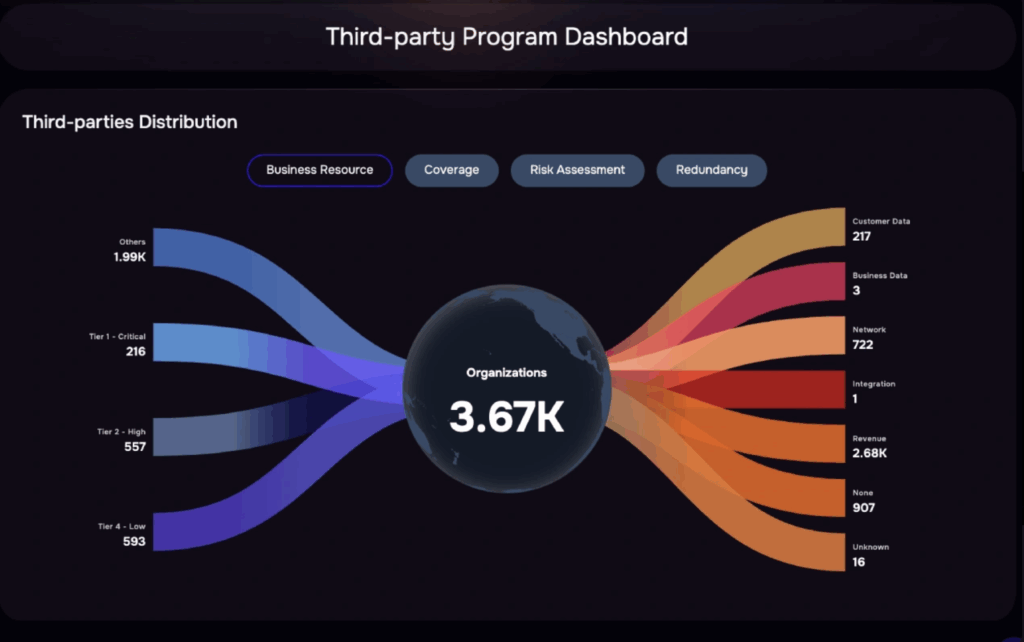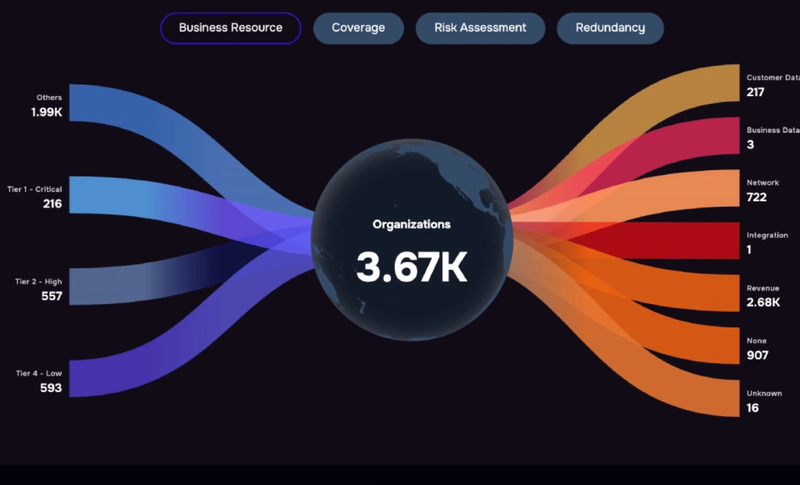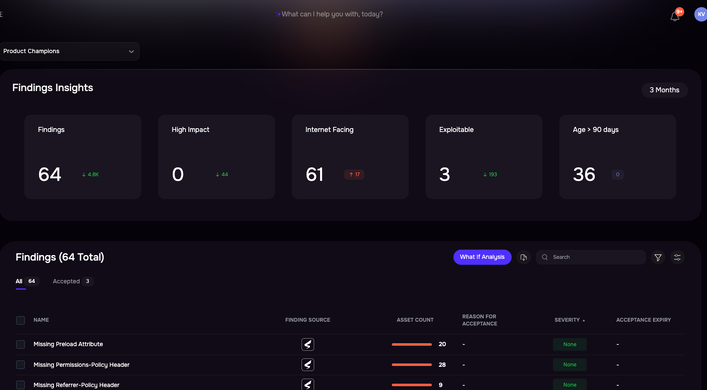Understand this vital tool in vendor risk management to secure your supply chain

TPRM on the SAFE One Platform
In this guide, you’ll learn:
• Why a TPRM framework matters — from protecting against costly breaches to meeting regulations like HIPAA, GDPR, and DORA.
• The business benefits — including stronger vendor accountability, centralized risk visibility, operational resilience, and better decision-making.
• How AI is transforming TPRM — shifting risk assessment from static, one-time checks to continuous, automated monitoring across the full vendor lifecycle.
• How to choose the right framework — including a side-by-side comparison of leading options like NIST CSF, ISO 27001, and Shared Assessments TPRM.
By the end, you’ll know how to select and implement a TPRM framework that not only reduces risk but also saves time, scales with your business, and builds lasting trust with partners.
Introduction
From cloud providers and payment processors to logistics partners and SaaS vendors, organizations depend on a wide range of third parties to stay competitive. However, with increased reliance comes increased risk.
Data breaches stemming from vendor vulnerabilities or security failures —like the infamous SolarWinds hack or the MOVEit exploit—have made one thing clear: the third-party risk management (TPRM) process is a critical part of enterprise risk management and a boardroom issue.
To effectively manage risk and maintain trust, businesses must adopt a robust third-party risk management framework tailored to their operations.
Key Point to Know Before You Evaluate TPRM Frameworks
Third-party risk management is at an inflection point. In a transition already well underway, artificial intelligence (AI) is transforming vendor risk management at every level. Particularly through AI agents (or agentic AI), risk assessment of third parties is shifting from a static event (often conducted after the organization had already decided to contract with the vendor) to an ongoing process at every stage of the vendor lifecycle from vendor selection to contract negotiation and onboarding to operational monitoring to offboarding. Pay careful attention to how any framework is adaptable to this new environment for third-party cyber risk management.
What Is a TPRM Framework?
A TPRM framework is a structured, repeatable process that helps organizations assess, monitor, and mitigate risks associated with third-party vendors. It provides the necessary guidelines, tools, and procedures to integrate third-party risk into broader governance, risk, and compliance (GRC) programs.
Broadly, there are two categories:
- TPRM-Centric Risk Frameworks
These are purpose-built for third-party risk, such as the Shared Assessments TPRM Framework or NIST 800-161. They provide deep insight into concerns specific to vendor risk management like access privileges, control testing, and data handling. - Supplementary Risk Frameworks
Frameworks like ISO 31000 or COSO ERM aren’t exclusively for TPRM but include components to manage external risks as part of enterprise-wide risk management.
Why Your Business Needs a TPRM Framework
1. Ensure Regulatory Compliance
Regulations like HIPAA, GDPR, CCPA, and DORA require organizations to manage the security and privacy risks posed by third parties. A formal third-party risk management framework helps demonstrate compliance through documentation and continuous oversight.
Example: A healthcare provider uses a TPRM framework to ensure its cloud-based patient records system complies with HIPAA by vetting vendor data protection practices.
2. Enhance Vendor Accountability
By enforcing a structured assessment and monitoring process, organizations can hold vendors accountable for adhering to security and performance standards.
3. Strengthen Cybersecurity Posture
Third parties are often the weakest link in your cybersecurity risk chain. A framework guides how to secure data sharing, manage access, and conduct audits.
4. Mitigate Operational and Financial Risk
Whether it’s a vendor going offline or exposing you to fines through non-compliance, managing third-party risks helps you stay operational and financially resilient.
5. Improve Decision-Making with Centralized Risk Data
A TPRM framework provides a single pane of glass for viewing vendor risks across the organization, helping teams make informed decisions about who to trust—and how much.
Types of Third-Party Risk Management Frameworks
Here’s a comparison of popular frameworks that can be applied to third-party risk management.
| Framework | Focus Area | Strengths | Considerations |
| NIST CSF | Cybersecurity | Widely adopted, flexible | Requires adaptation for vendor-specific risk |
| ISO 27001/27002 | Information security controls | Globally recognized, strong controls | Certification cost; general scope |
| NIST RMF | Lifecycle risk management | End-to-end risk governance | Federal-heavy orientation |
| COSO ERM | Enterprise risk | Strategic alignment | Less technical depth |
| ISO 31000 | General risk management | Broad, industry-neutral | Limited TPRM guidance |
| Shared Assessments TPRM | Vendor risk | TPRM-specific tools and templates | Costly. May require integration with broader GRC |
| NIST 800-161 | Supply chain risk | In-depth for critical sectors | Complex, specialized focus |
How to Choose the Right TPRM Framework: Step-by-Step
1. Understand Your Needs and Risk Profile
Start by evaluating:
- Regulatory requirements: Are you subject to HIPAA, GDPR, DORA, etc.?
- Vendor count: Large organizations may run a supply chain with thousands of suppliers and partners.
- Risk tolerance: How much loss exposure are you willing to accept from third parties – and their vendors (your fourth parties)
- Vendor dependencies: Do you rely on high-risk vendors for critical operations? Watch out for single points of failure.
- Vendor types: IT service providers, logistics, SaaS vendors, data storage – each instance of shared data or processes carry their own risks.
Example: A fintech company dealing with customer data prioritizes ISO 27001 for strong information security.
2. Research and Evaluate Framework Options
Look into industry-standard frameworks (e.g., NIST CSF), TPRM-specific frameworks (e.g., Shared Assessments) and frameworks specific to your industry (FINRA, HIPAA). Match them against your regulatory and operational needs.
3. Compare and Contrast Frameworks
Evaluate based on:
- Risk coverage – Does it include fourth-party risks?
- Onboarding support – How does it handle vendor selection and contracting?
- Workflow integration – Can it be embedded into your procurement or GRC tools?
- Continuous monitoring – Does it support real-time alerts and assessments?
- Automation – Is the framework supported by a technology solution, ideally leveraging AI?
4. Select the Framework That Best Fits Your Business
Choose based on:
- Alignment with regulatory compliance and business goals
- Ease of implementation
- Support for continuous monitoring
- Scalability and future-readiness
5. Implement and Continuously Improve
Roll out your TPRM program with a defined lifecycle:
- Planning & Identification: Develop a short list of vendors specific to your need for support. Automate vendor discovery and intake form analysis for fast decision-making.
- Due Diligence & Selection: Accelerate the process with automation and AI-powered insights. Take a proactive, risk-based approach with outside-in and inside-out visibility into risk factors, along with public data scanning, bulk ingestion of questionnaires, leading to smart ranking of vendor candidates.
- Contracting & Onboarding: Scan and assess contracts at scale with AI-powered tools to spot missing clauses, compliance risks and security misalignments. Automate communication with vendors. Map downstream vendors to spotlight fourth-party risks.
- Ongoing Monitoring: Track third-party risk posture over time and implement alerts on key changes, breaches, vulnerabilities or other reassessment triggers – eliminating static, point-in-time assessments.
- Termination & Offboarding: With AI, automate data destruction and run end-of-contract assessment of residual risks.
Tip: Automate vendor assessments using questionnaires tied to the third-party risk framework and set reminders for reassessments.
Desirable Features in a TPRM Program
- Automation: Use tools to streamline due diligence, document collection, and security questionnaires.
- Platform Support: Look for a framework supported by a comprehensive platform solution that automates each phase of the framework and provides oversight.
- Continuous Monitoring: Stay ahead of new threats with live data feeds and real-time risk scoring.
- Fourth-Party Visibility: Know who your vendors rely on—and how that affects your own risk profiles.
- TPRM Technology Solutions: Adopt platforms like SAFE Security, Prevalent, or OneTrust to enable efficient execution of your framework.
- Risk Quantification: Convert technical risks into financial terms to communicate with executives and justify investments.
Conclusion
Choosing the right TPRM framework is a strategic decision that impacts your organization’s security, compliance, and resilience. By aligning a framework with your risk profile, regulatory environment, and operational needs, you can better protect your business from third-party vulnerabilities and foster long-term trust with partners.
Implement TPRM Frameworks Efficiently with SAFE Security
With SAFE Security, your organization can implement leading TPRM frameworks, automate third-party risk assessments, and gain real-time visibility into your entire vendor ecosystem. Whether you’re aiming to align with ISO 27001, NIST, or a tailored TPRM-specific framework, SAFE can help scale your risk program with confidence. Need help evaluating or implementing a TPRM framework? Let’s talk.
Title tag: How to Choose the Right TPRM Framework for Your Business?Meta description: Uncover our expert guide and learn what is a tprm framework and the step-by-step process of choosing the one for your business


